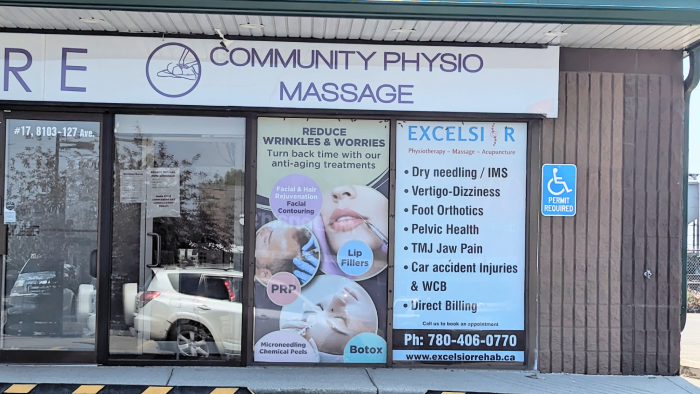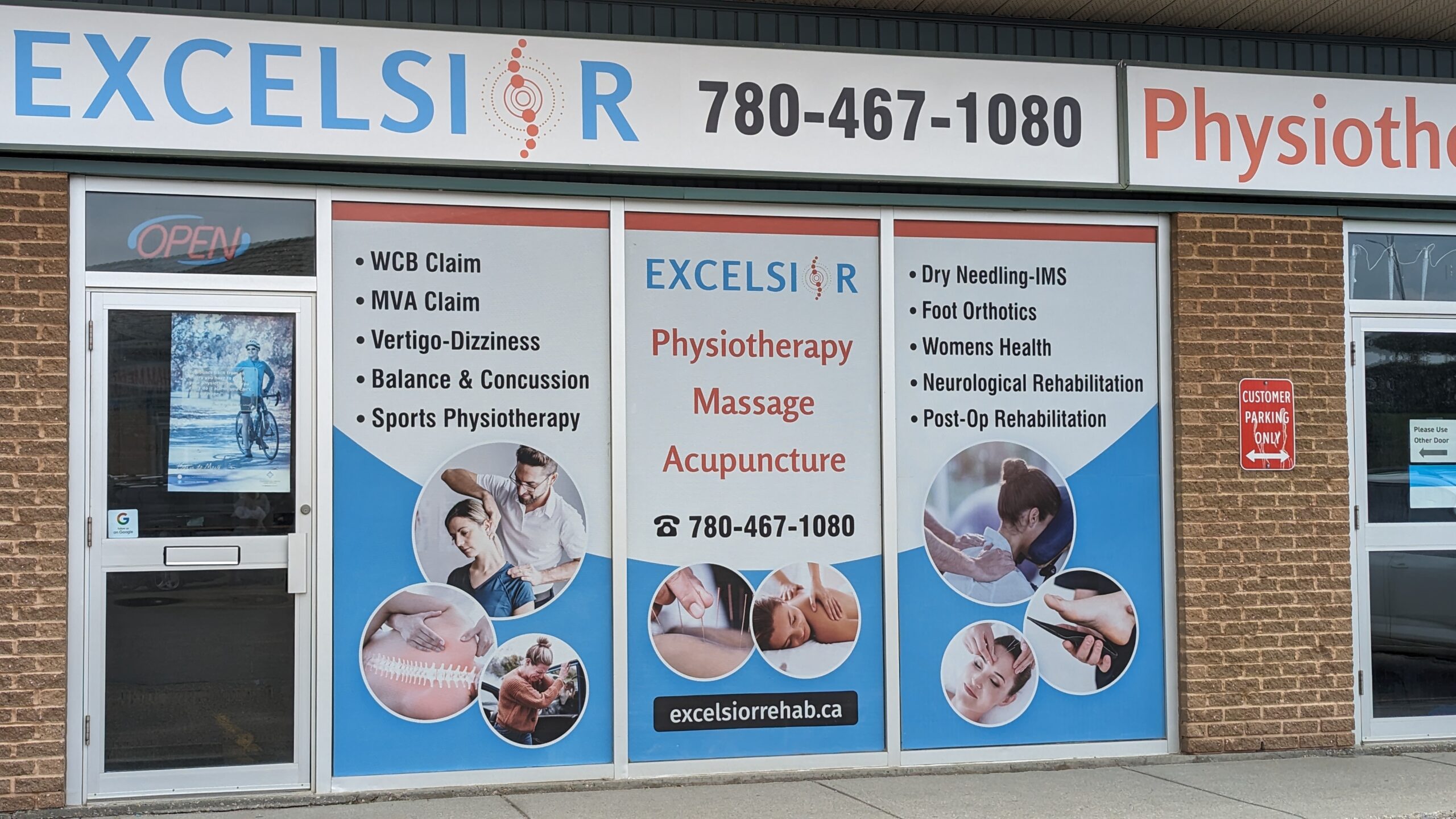ANKLE SPRAIN AND INSTABILITY
Home » ANKLE SPRAIN AND INSTABILITY
Physiotherapy in Edmonton for Ankle Issues
We welcome you to Excelsior Physiotherapy’s patient information resource on ankle sprain and instability.
A sprain in your ankle is a common injury that occurs when the ankle gets turned or twisted. The word sprain refers to the soft tissue injury related to the ankle ligaments.
Our informative guide will focus on:
- How do you develop an ankle sprain?
- How the ankle sprain is diagnosed?
- What treatment is best for treating the ankle sprain
Which Part of the Ankle Will Get Affected?
Ligaments are sturdy tissue bands, which bond the bones closely. Three different ligaments form the complex structure called lateral ligament lying at the farthest end of the other ankle. They are:
- PTFL or posterior talofibular ligament
- CFL or calcaneofibular ligament
- ATFL or anterior talofibular ligament
Both CFL and ATFL are prone to injury, as CFL prevents the ankle from rolling inwards while the ATFL prevents the ankle from sliding to the front.
Causes of Ankle Sprain
The ligament comprises various connective tissue strands like that of a nylon rope. A sprain is caused when your ligament tears or stretches. The degree of ligament injury is based on the extent of the sprain.
Connective Tissue
The lateral ligaments are the highly injured ones when it is about typical ankle inversion sprain. When your ankle gets tilted inwards, the lower part of the foot looks towards the other foot. It put force on applying the body weight pressure to the ankle’s outside edge. So, the ligaments get stretched and torn. ankle syndesmosis injury or severe ankle sprain occurs when the supportive ankle ligaments are damaged badly.
It is also called a high ankle sprain as the joint’s ligaments are also affected. At least a single ligament that connects both the fibula and tibia will be sprained during this condition. Recovering from such acute injuries usually takes double the healing time of a general ankle sprain.
How Painful Is the Ankle Sprain?
Usually, the injured ankle will have bruising, swelling and pain, as the soft tissues will be damaged and blood vessels would have ruptured. The initial inflammation is due to the bleeding occurring at the tissue level. The inflamed ankle swells up due to the accumulation of fluid in the tissues within 24 hours of the ankle sprain.
Some people might face frequent ankle spraining because their ankle keeps turning when performing any work, which is termed ankle instability. Patients facing ankle instability don’t feel good when walking on uneven floors, as their ankles might fail to support. Usually, ankle swelling doesn’t decrease with time. The reflex of the muscles around the affected joints is very low, which causes the ankle to turn or twist frequently. People having mild to severe ankle sprains will also face issues like impingement in the long run. The sprained ligaments will turn thicker and get irrigated, thereby creating a pinching pain at the ankle joint.
Diagnosing Ankle Sprain: Physiotherapy Treatment in Edmonton
After an initial assessment, the physiotherapist at Excelsior Physiotherapy will discuss with you the findings and chart out a personalized therapy program. The physiotherapist would also require additional tests to identify the actual cause behind the injury.
What Can You Expect During Ankle Injury Rehabilitation?
- During your consultation at Excelsior Physiotherapy, new perform a physical examination for evaluating and determining the extent of the injury and the ligament that has been damaged.
- Our physiotherapist would move the sprained ankle in various positions for checking the condition of the soft tissues and ligaments surrounding the ankle.
- A few of our tests would put a bit of pressure on the ligaments of your ankle to check the degree of stability and identify if there are any ruptured ligaments.
- X-ray tests would be suggested to check the ligament’s health.
Treatment for Ankle Sprain: Physiotherapy Treatment in Edmonton
- Non-surgical Rehabilitation: Even if you didn’t go for the surgical option, you must follow our rehabilitation and exercise program to treat the ankle sprain. At Excelsior Physiotherapy, we develop a customized treatment program for ankle sprain for regaining mobility and enhance ankle coordination.
- Massage Therapy: Pain and inflammation are treated using electrical stimulation and ice stimulation. If ankle swelling is serious, then we suggest massage therapy. Our massage therapists will apply a bit of pressure through massage strokes between the knee and ankle by elevating your leg. It is useful for removing fluid buildup and encouraging circulation. Our physiotherapist will use a compression wrap around the affected ankle and lower limb.
- RICE Treatment: As soon as you experience a severe ankle sprain, our physiotherapists in Edmonton would suggest first-hand treatments for stopping the pain and inflammation and to prevent the ankle from getting affected due to weight bearing. This treatment is called RICE, where R stands for rest, I for ice, C for compression, and E for elevation.
- Joint Mobilization Treatment: It is for enhancing normal joint function and restoring the gliding motion of ankle bones.
- Disc Training: We help you perform disc training using a sphere-fitted circular platform where you can stand and tilt the disc in different ways. It enhances ankle muscle strength, position, and balance.
Post-Surgical Rehabilitation
- Patients are advised to take up physiotherapy after surgery for ankle issues. With physiotherapy, you will be able to get complete recovery within 6 months period.
- Ankle braces will be prescribed to improve your ankle’s weight-bearing ability.
- Instructions to use crutches without harming the knee by suggesting the recommended amount of weight.
- Our physiotherapy sessions for a couple of weeks will be to control inflammation and pain due to surgery.
- We will use electrical stimulation and ice stimulation modality to ease muscle spasms and pain. We also help enhance the range of motion of the ankle without causing strain to the affected ligaments.
- After 6 weeks, we will teach you active exercises for strengthening the peroneal muscles. Our Excelsior Physiotherapy experts offer these exercises to enhance stability and retain a position for a few minutes.
Doctor Review
If your ligaments are fully ruptured, then consult a physician for stress X-rays to check them in a stretched position. It will show the ankle bone with a slight tilt when you have a ligament tear.
Surgical Options
- Ligament Tightening Procedure: It is performed for correcting the stretched ligaments of CFL and ATFL, and to promote ankle stability. It is an invasive procedure.
- Tendon Graft Procedure: It is a tendon graft reconstruction procedure, which can repair the scarred and damaged ligaments. It is also an invasive procedure.






